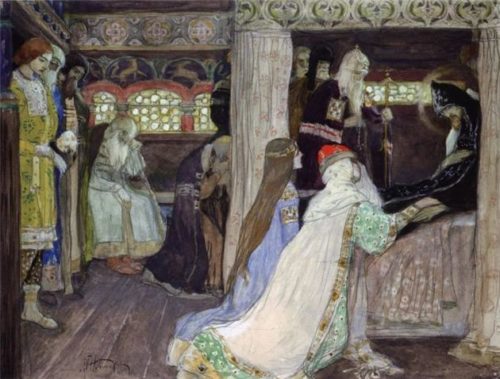
Saint Russia by Mikhail Nesterov. Russian artist Mikhail Vasilievich Nesterov (31 May 1862 – 18 October 1942) was born in Ufa into a merchant family. He received higher artistic education at the Moscow School of Painting, Sculpture and Architecture (1877-1881 and 1884-1886), where his teachers were V.G. Perov, A.K. Savrasov, I.M. Pryanishnikov and the Academy of Arts (1881-1884), where he studied at P.P. Chistyakov. Mikhail Nesterov lived mainly in Moscow, and visited Western Europe, including France and Italy. He worked in Moscow (Abramtzevo Trinity-Sergius Lavra and their surroundings). Was a member of the “Association of the Wanderers.”

His early paintings more often depicted everyday life, then later, they showed folklore character (“For the love potion”, 1888), the atmosphere of religious legends (“The Hermit” , 1888-1889). Painting under the influence of French symbolism emphasized idyllic sincere unity of his characters and the natural environment. This is the famous “Young Bartholomew’s Vision” (future Sergius of Radonezh, 1889-1890), written near Abramtzevo – painting, where with a wonderful feeling permeated equally figures and the typical-central Russian landscapes.

Since then the artist has been working in the field of religious and monumental-decorative art: painting in the cathedral in Kiev (1890-1895), created mosaics and icons in the Church of the Savior on Spilled Blood in St. Petersburg (1894-1897), painted in the church of Alexander Nevsky in Abastuman (1902-1904), the Intercession Church of Martha and Mary Convent in Moscow (1908-1911). Here was fixed the tradition of “church modernity” that fills canonical church stories with deep lyricism.

In the monumental lyrical portraits of the artist most expressive were the images of relatives and close spiritual people (“Amazon”, 1906, “Philosophers”, 1917). In large, “cathedral” pictures Nesterov seeks to express the great frontiers of spiritual renewal (“Great vows” 1897 “Holy Russia”, 1901-1906). The biggest painting of the master, “In Russia” (“soul of the people”, 1916), includes “The Enchanted Wanderer” figures of Dostoevsky. Tolstoy and Vladimir Solovyov. Always very important, and sometimes self-worth role of lyrical landscape (painted after Solovki impressions “Silence,” 1903).

After the revolution Nesterov retires in artwork. Religious subjects are still present in the works. During these years, the artist best expresses himself in portraits. These are the “Artists A.D. and P.D. Korins” (1930), “Academician Pavlov” (1935), “Sculptor I.D.Shadr” (1934), “The sculptor Vera Mukhina” (1940), etc. In the last decades of his life Nesterov enthusiastically worked on the memories that came out as a book (titled “the old days”) in the year of his death. Nesterov died in Moscow October 18, 1942.




